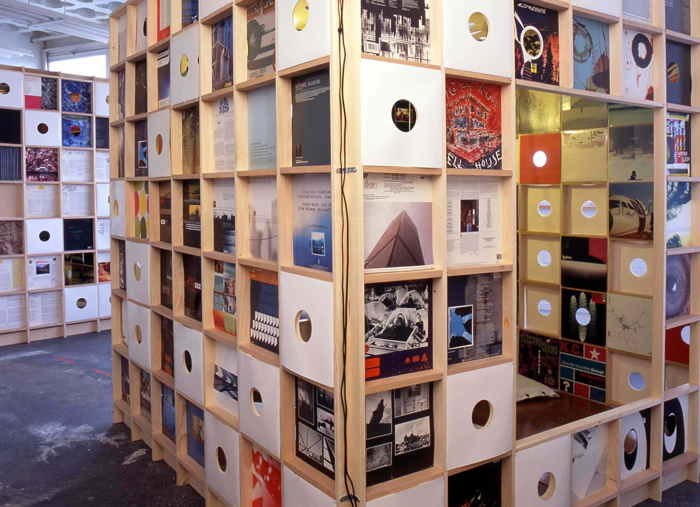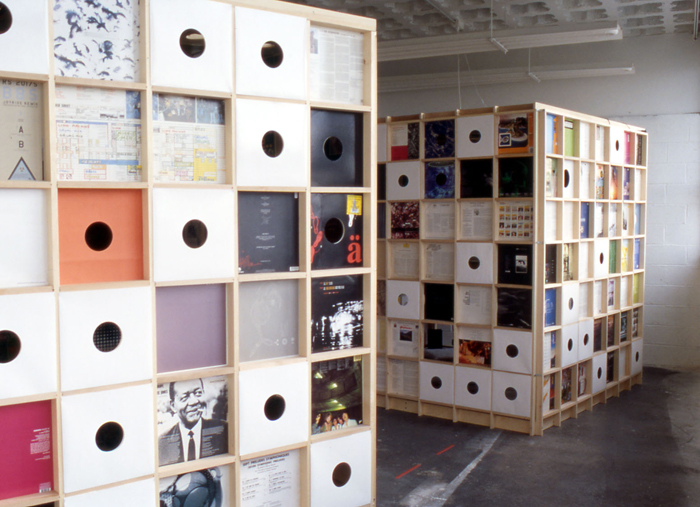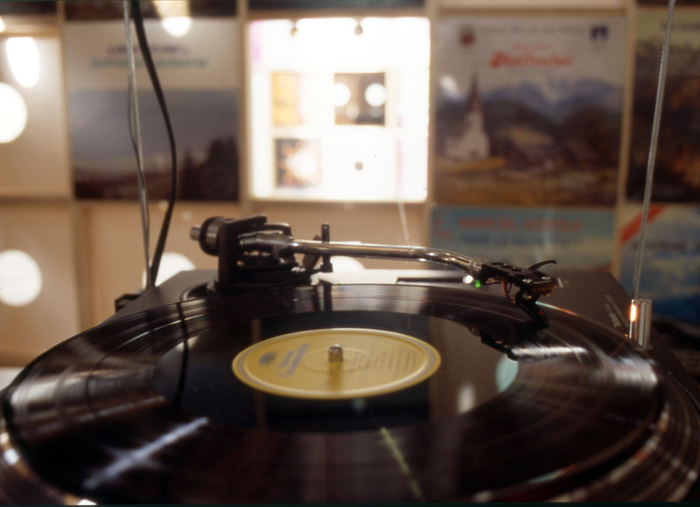| Nowhere-Lands, 2001-2003 |
Approximately 500 record sleeves (representing cities, mountains, beaches, skies, deserts), vinyl records, 2 "Technics" turntables, amplifiers, 4 loudspeakers, cushions, wood, variable dimensions
Produced for the exhibition Paysages d'entre-villes, Musée Zadkine, Paris, 2001
Production: Musée Zadkine, Paris; Galerie Grégoire Maisonneuve, Paris
Curator: François Quintin
Collection: Frac Champagne Ardennes
Nowhere-Lands was produced for the exhibition Paysages d'entre-villes at the Zadkine Museum in Paris around the theme of the wasteland. Familiar with this theme, among others with a work entitled Le Jardin des choses nommées, the exhaustive inventory of a wasteland, Jan Kopp chose to interpret these hybrid landscapes through the use of sound. He places two record players opposite each other whose arms are connected by a thin string. Thus, under the opposing action of the two sapphires, the spectator cannot hear one music without being distorted by the other. These rival harmonies produce a new state of musical listening, both combined and uncertain. Each turntable is placed in a sort of comfortable hut in which the audience is invited to stay. These huts in the shape of cubic claustras are covered with the covers of the records used in the sound installation. The reference to the landscape is renewed by the choice of the covers, each one presenting a stereotypical aspect of the genre, whatever the origin of the music they illustrate. The thread stretched between the arms of the turntables links the two spaces. Parents of the sculpture, the sound installation, or even environmental, it is above all a device whose magic of letting go, the pleasure of the uncertainty, of the good expectations, hold truly to a thread.
Produced for the exhibition Paysages d'entre-villes, Musée Zadkine, Paris, 2001
Production: Musée Zadkine, Paris; Galerie Grégoire Maisonneuve, Paris
Curator: François Quintin
Collection: Frac Champagne Ardennes
Nowhere-Lands was produced for the exhibition Paysages d'entre-villes at the Zadkine Museum in Paris around the theme of the wasteland. Familiar with this theme, among others with a work entitled Le Jardin des choses nommées, the exhaustive inventory of a wasteland, Jan Kopp chose to interpret these hybrid landscapes through the use of sound. He places two record players opposite each other whose arms are connected by a thin string. Thus, under the opposing action of the two sapphires, the spectator cannot hear one music without being distorted by the other. These rival harmonies produce a new state of musical listening, both combined and uncertain. Each turntable is placed in a sort of comfortable hut in which the audience is invited to stay. These huts in the shape of cubic claustras are covered with the covers of the records used in the sound installation. The reference to the landscape is renewed by the choice of the covers, each one presenting a stereotypical aspect of the genre, whatever the origin of the music they illustrate. The thread stretched between the arms of the turntables links the two spaces. Parents of the sculpture, the sound installation, or even environmental, it is above all a device whose magic of letting go, the pleasure of the uncertainty, of the good expectations, hold truly to a thread.



